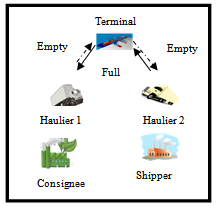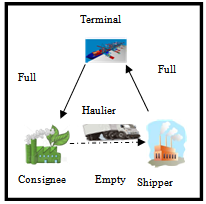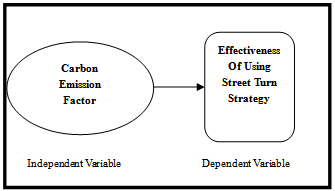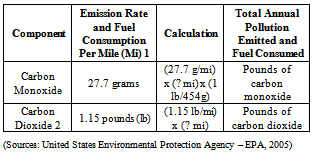-
Paper Information
- Next Paper
- Previous Paper
- Paper Submission
-
Journal Information
- About This Journal
- Editorial Board
- Current Issue
- Archive
- Author Guidelines
- Contact Us
Management
p-ISSN: 2162-9374 e-ISSN: 2162-8416
2013; 3(1): 16-19
doi:10.5923/j.mm.20130301.04
‘Street Turn’ Strategy: An Analysis of its Effectiveness as a ‘Green Logistics’ Tool for the Management of Empty Containers for Road Haulage in Malaysia
Nur Farizan Tarudin
Department Postgraduate Student, Malaysia Institute of Transport (MITRANS), Universiti Teknologi MARA, 40450, Shah Alam, Selangor, Malaysia
Correspondence to: Nur Farizan Tarudin , Department Postgraduate Student, Malaysia Institute of Transport (MITRANS), Universiti Teknologi MARA, 40450, Shah Alam, Selangor, Malaysia.
| Email: |  |
Copyright © 2012 Scientific & Academic Publishing. All Rights Reserved.
The problem of empty containers is not unique to Malaysia but also a major problem that is faced by other countries around the world. An effective strategy of managing empty containers not only enable financial savings, but it also has the added advantage of contributing to the well being of the environment. Therefore, several strategies have been identified and implemented to reduce or minimize the environmental impact of moving around empty containers. The practice of industry in Europe in managing the container movement is based largely on two strategies called ‘Depot Direct’ and ‘Street Turn’. These strategies are looked upon as suitable tools for managing container’s entire – journey when there is a haulage by prime movers. However in Malaysia, logistics practitioners have still largely not implemented a similar strategy in the latter that forms the foundation of green logistics thus helping to reduce carbon emissions in Malaysia. Normally, road haulage companies in Malaysia use the ‘Depot Direct’ strategy and from the general observation this strategy is not an environmental friendly process as it entails unnecessary carbon emissions. This author seeks to determine whether there is an environmental benefit if there is implementation of a new strategy like ‘Street Turn’ in Malaysia for container haulage operations.
Keywords: Street Turn, Depot Direct, Green Logistic, Carbon Dioxide (CO2), Carbon Monoxide, Prime Mover Containers
Cite this paper: Nur Farizan Tarudin , ‘Street Turn’ Strategy: An Analysis of its Effectiveness as a ‘Green Logistics’ Tool for the Management of Empty Containers for Road Haulage in Malaysia, Management, Vol. 3 No. 1, 2013, pp. 16-19. doi: 10.5923/j.mm.20130301.04.
Article Outline
1. Introduction
- Currently, the logistics and transportation industry in Malaysia has been growing very quickly in response to the pressures of globalization. This sector is one of the biggest industries in Malaysia and it is large enough to have a significant impact on the environment. Therefore in order to reduce global warming and support the green logistic practices, it is important to implement a logistics and transportation strategy that is friendlier to the environment. Referring to a study conducted by Rodrigue, J.P., (2011), the logistics and transport industry are looking at one of the major contributors to environmental issues by measuring its various modes and infrastructures. Based on this scenario, the logistics and transport sector has an opportunity to adopt more environmentally friendly practices and present a more environmentally friendly face to the world at large. At the heart of this development in the logistics industry is the container haulage sector. However, this mode of transporting goods is not an environmentally friendly process. By looking at European countries, prime-movers contribute up to 10 percent (10%) of the carbon dioxide emissions[2]. In addition, there are similar vehicles used in Malaysia, therefore emission levels should not be largely dissimilar. Road Haulage companies in Europe are used in combination of two strategies called ‘Depot Direct’ and ‘Street Turn’, to manage their empty container movement problems. However in Malaysia, a lot of logistics operators do not implement this strategy although it contributes to carbon emission reduction and thus directly support the green logistic industry in Malaysia. This study will be a guideline on the effectiveness the ‘Street Turn’ strategy with respect to carbon emission reduction.
2. Problem Statement
- The normal operation of container haulage is usually plagued with inefficiency due to vehicle utilization according to Hanh, L.D., (2003). Hanh had found that for inbound and outbound cargo, at least two thirds of container haulage trips involved empty container movements, either in empty pickup or empty return (see Figure 1: Depot Direct strategy). This observation is also supported by McKinnon, A. C., (2007), who observed that empty journeys are not only wasteful economically, but also carry an environmental problem. The aim of the ‘Street Turn’ management strategy is not only to reduce the problem of empty containers but also to support the principles of green logistics in managing global warming issues.
 | Figure 1. Depot Direct strategy |
 | Figure 2. Street Turn strategy |
3. Research Framework
- The measurement of the effectiveness of the ‘Street Turn’ strategy as a green logistic tool was measured by focusing on four (4) major elements. These elements consist of vehicle utilisation, road traffic selection and survey, vehicle maintenance and estimation of the percentage of carbon reduction. All the elements referred to the ‘Vehicular exhaust emission modelling tree’ that was included in the study conducted by Pandian, S., Gokhale, S., and Ghoshal, A.K., (2008). According to this study, the researchers noted that emission rates depend on the characteristic of traffic, vehicles and the type of road intersection. For example, engine characteristic, vehicle maintenance, condition and type of emission control equipment and age of vehicle.
 | Figure 3. Research Framework |
4. Methodology
4.1. Sampling Procedures
- The population of this study consists of companies that are involved with the haulage of containers in Shah Alam and Klang, Selangor. There are 162 container haulage companies from the 344 companies that are involved with the the transport and logistics business. (see Table 1). Based on this population, researcher selected a sample by using the stratified random sampling method. This was considered as the most efficient sampling design when differentiated information is needed from the various strata within the population[11]. The optimum sample size was determined based on the sampling table provided by Krejcie and Morgan (1970).
|
4.2. Pilot Testing
- Once the instrument was ready pilot testing was done to determine the appropriateness of the questionnaire. After respondents have validated the content of the questionnaire, minor changes were incorporated into the final design of the questionnaire based upon the feedback received. To ensure consistency and reliability, a standard definition of the Street Turn strategy was provided to the interviewees prior to being asked the questions in the questionnaire. Internal consistency and reliability measurements of the items will be verified by computing the Cronbach’s coefficient Alpha, and a minimum Alpha of 0.60 will suffice in the pilot survey[8]. Around 10 samples to represent the study population were selected for the pilot study and feedback from pilot respondents were used to further improve and refine the survey instruments.
4.3. Quantitative
- A quantitative study is more appropriate for this research because answering the main research question for this study involves obtaining a lot of information from the road Haulage Company that cannot be quantified in the standard manner. Besides that, the researcher used estimation calculation to calculate percentage of carbon emission before and after implementing this strategy. This calculation was based on the carbon emission for the passenger and truck standard formula from United States Environmental Protection Agency. A formula that will be used is as follows:
|
5. Results
- The findings indicate that the majority of road haulage operators for containers in Malaysia not agree that carbon emission can reduce from the ‘Street Turn’ strategy based on several factors such as driver behavior. Therefore, estimation calculation had done to confirm this result. After calculation had been made, the total average carbon monoxide and carbon dioxide emission reduction of these three categories (small, medium and big companies) under the ‘Street Turn’ strategy is small, i.e. 0.45kg of carbon monoxide and 8.41kg of carbon dioxide respectively. Referring to the Tioga Group Study, (2002), the potential for empty container reuse or the ‘Street Turn’ strategy, off-dock empty return depots and depot-direct-off-hires had shown the result of carbon emission reduction 1.04 tons per annually (12.26%) for the potential empty container reuse strategy implementation. As a conclusion, from this result it had shown that, even though the percentage of carbon emission reduction small for the ‘Street Turn’ strategy implementation but there is still room for improvement in the future.
6. Conclusions and Future Research
- Previous studies show that the implementation of “Street Turn” strategy for ocean carriers, shippers, and trucking companies result in greater equipment utilization, improve operating efficiencies, and reduce empty container mileage. Other than that, terminals can alleviate congestion and its associated problems. Considerable environmental benefits are also attainable, in the form of reduced truck traffic and diesel emission. Besides that, it had significant potential to reduce congestion in port terminals, rail ramps and inland container depots, to lower ocean carriers’ and tracking companies’ costs of dispatching empty containers, and to create greater efficiency for shippers. For future research, it is the suggestion of the researcher that more studies be done on an experimental design so that detailed calculation could be made to determine which factors lead to the largest carbon emission saving with respect to the movement of empty containers. .
ACKNOWLEDGEMENTS
- This work is supported by the Malaysia Institute of Transports (MITRANS) located at the Universiti Teknologi MARA (UiTM), Shah Alam, Malaysia . Special thanks to my supervisor Assoc. Prof. Dr. Irwin U.J. Ooi, who was always around to supervise my work and also to those who have in one way or another contributed to the success of completing this paper.
 Abstract
Abstract Reference
Reference Full-Text PDF
Full-Text PDF Full-text HTML
Full-text HTML